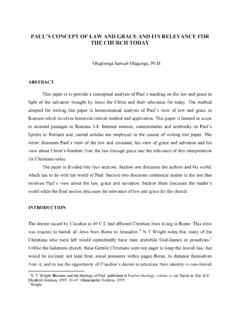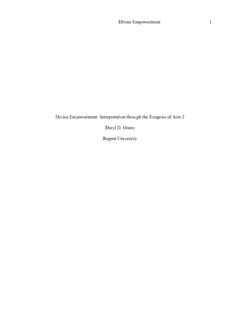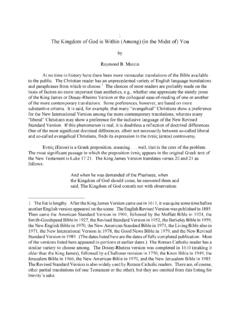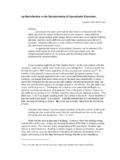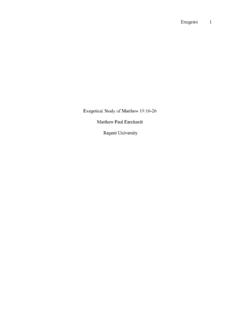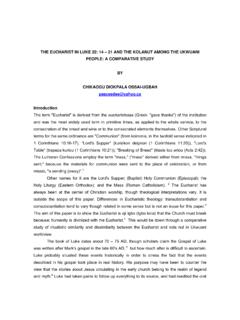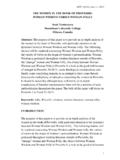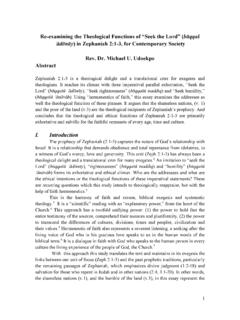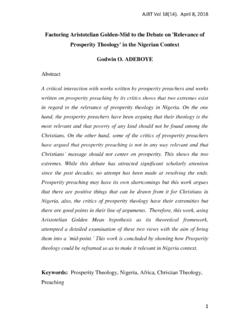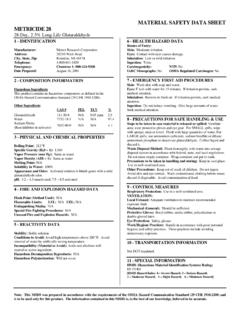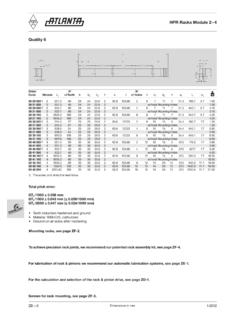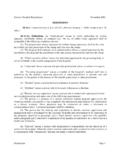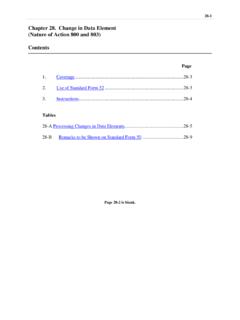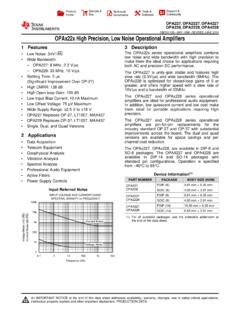Transcription of Dating Christ's Crucifixion - Biblical Theology
1 Dating Christ's Crucifixion Abstract: This paper reevaluates the possible date for the death of Jesus christ based on W. Graham Scroggie's postulate for the day of the Crucifixion . The analysis shows a remarkable alignment of astronomical data with historical evidence, when assessed with a new understanding of the length of Christ's ministry. It was found that christ began his ministry in the spring/summer of AD 26 and was crucified on Wed April 28, AD 28. (Julian). 1 Historical perspective on the date of the Crucifixion A commonly proposed date for the Crucifixion of christ is Friday April 3, AD-33. This was the conclusion of Fotheringham (1934)[1, 2], Hoehner (1978)[3], Humphreys and Waddington (1985)[4], Schaeffer (1990)[5] and others.
2 Newton also considered this date but preferred Friday April 23, AD-34[6]. Various other dates have been proffered, among which are proponents of the Wednesday Crucifixion on April 25, AD-31[7]. 2 Difficulties with the Friday Crucifixion The grave problem with a Friday Crucifixion is the difficulty in reconciling it with the Biblical record. Scroggie (1948)[8] postulated a Wednesday evening burial and Saturday evening resurrection that is more plausible and Banks[9] has comprehensively outlined the problems with both the Friday and Thursday Crucifixion scenarios. In brief, the discrepancies raised by the Friday evening Crucifixion and Sunday morning resurrection are as follows.
3 A) Matt 12:40 is emphatic that christ would lie in the grave for three days and three nights. This is no minor matter to be ignored or trivialized since christ indicated that it is the only sign of his messiahship (Matt 12:39; Luke 11:29~30). Neither the Friday or Thursday Crucifixion days satisfy these criteria. b) The weight of the evidence is that christ was not resurrected on Sunday morning. All the gospels agree that when the women came to the tomb early Sunday morning, christ was not there (Matt 28:1; Mark 16:2; Luke 24:1; John20:1). John's account points out that it was still dark when they came to the tomb.
4 This makes the Friday Crucifixion date even more untenable since it effectively removes any fraction of the Sunday daylight period from the count. Most translations of Mark 16:9 have interjected the word Jesus' into the verse and wrongly give the impression that Jesus rose on the first day of the week. The New International Version, based on the minority texts, even discounts the whole section from Mark 16:9 ~ 20[10]. c) Considering the events that transpired from Jesus' death at about (Matt 27:45) to the time he was placed in the tomb, it is likely that Jesus was placed in the tomb at dusk (Matt 27:57). This situation will also remove a partial daylight period from the count and further calls into question the Friday Crucifixion .
5 D) John 19:31 makes it clear that the Sabbath following Christ's Crucifixion was a high day' or an annual Sabbath which could fall on almost any day of the week (Lev 23:5~7). The weekly Sabbath by comparison begins at twilight on Friday and ends at twilight on Saturday (See section ). The misunderstanding of this distinction is perhaps the prime reason why so many analyses have gravitated to Friday Crucifixion date. e) Luke 23:56 tells us that the women prepared spices and then rested on the Sabbath. Since a High Day Sabbath followed the Crucifixion , the spices could not be prepared until after the High Day Sabbath had come to an end.
6 Luke 23:56. requires another Sabbath rest day following the High Day Sabbath, which a Friday Crucifixion /Sunday resurrection does not allow. This verse also negates a Thursday Crucifixion , since the day following the Crucifixion was a High Day Sabbath and no work was to be done (Lev 23:7), leaving no opportunity for the women to prepare spices before the weekly Sabbath started. The widespread fixation on a Friday Crucifixion in the face of such compelling Biblical contradiction is puzzling, especially since the historical details of the process of adoption of the Easter tradition following the Quartodeciman controversy' is well documented[11].
7 3 First century Jewish Passover Practice To decipher the events surrounding Christ's death and resurrection, they must be examined in the context of Jewish religious practices at the time. The term Jewish' is taken to be a regional descriptor for all the Israelitish inhabitants of the area including the descendents of the tribe of Judah and priestly tribe of Levi. Two items in particular that help bring clarity to the Gospel accounts are: a) An understanding of how the Jews counted the day. b) An understanding of how different sects observed the Jewish Spring Holy Days. The Jewish Day Stroes[12] and other researchers[7](chap 5) have pointed out the difficulties in exegesis for words translated day' in the Bible and also for terms relating to the day, such as morning', evening' and between the evenings'.
8 Zeitlin[13] has also highlighted possible changes in time reference in the Old Testament. However, for the period of Christ's life, there is consensus that the dominant Jewish sects counted the start of the day at twilight, so that a full day consisted of the night period followed by the daylight period[7](pg 52). Mark 1:21, 32 is a confirmation of this practice, since the people waited until the Sabbath ended at sunset, before bringing their sick to Jesus. Harmonizing John 19:14. The timeline of the Synoptics is a Crucifixion followed by a period of darkness from noon to , when christ dies (Mark 15:25, 33; Matt 27:45; Luke 23:44).
9 In John 19:14 however, the term sixth hour' (KJV) is used and many have assumed that John was referring to the time just before the Crucifixion . Some authors have proposed that the sixth hour' in the Roman system of timekeeping is about , and signified the time that Jesus was brought to Pilate for questioning. Wright[14] has highlighted the difficulties in this interpretation since the placement of John 19:14 is after the trials by Pilate and immediately precedes the Crucifixion . In examining the other scriptures where John gives the time of day (John 1:39; 4:6, 52), the context is consistent with the Jewish system of timekeeping.
10 In any event, it seems implausible that Pilate's Judgment hall would be open as early as , since that corresponds to daybreak around the time of the spring equinox at Jerusalem's latitude. The difficulty can be resolved if the term sixth hour' is associated with preparation for the Passover, so that a paraphrase of John 19:14 would read as follows: Now preparations for the Passover (sacrifice) started at noon, so he (Pilate) said to the Jews Here is your King. '. The issue was that Pilate was being pressed to make a decision, since the Jews had to start preparations at noon for the sacrifice of Passover Lambs.

